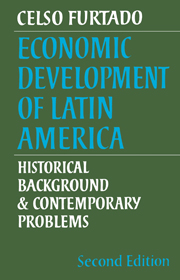Book contents
- Frontmatter
- Contents
- Tables
- Preface to the second edition
- Preface to the first edition
- Abbreviations
- Maps
- PART ONE FROM THE CONQUEST TO THE FORMATION OF NATION-STATES
- PART TWO ENTRY INTO THE SYSTEM OF INTERNATIONAL DIVISION OF LABOUR
- PART THREE THE TRADITIONAL STRUCTURAL PATTERN
- PART FOUR CHARACTERISTICS OF THE INDUSTRIALISATION PROCESS
- 10 The industrialisation process. i: The initial phase
- 11 The industrialisation process 2: Import substitution
- 12 Imbalances created by import-substituting industrialisation: structural inflation
- PART FIVE REORIENTATION OF DEVELOPMENT IN THE RECENT PERIOD
- PART SIX INTERNATIONAL RELATIONS
- PART SEVEN INTRA-REGIONAL RELATIONS
- PART EIGHT STRUCTURAL RECONSTRUCTION POLICIES
- Bibliography
- Index
12 - Imbalances created by import-substituting industrialisation: structural inflation
Published online by Cambridge University Press: 25 January 2010
- Frontmatter
- Contents
- Tables
- Preface to the second edition
- Preface to the first edition
- Abbreviations
- Maps
- PART ONE FROM THE CONQUEST TO THE FORMATION OF NATION-STATES
- PART TWO ENTRY INTO THE SYSTEM OF INTERNATIONAL DIVISION OF LABOUR
- PART THREE THE TRADITIONAL STRUCTURAL PATTERN
- PART FOUR CHARACTERISTICS OF THE INDUSTRIALISATION PROCESS
- 10 The industrialisation process. i: The initial phase
- 11 The industrialisation process 2: Import substitution
- 12 Imbalances created by import-substituting industrialisation: structural inflation
- PART FIVE REORIENTATION OF DEVELOPMENT IN THE RECENT PERIOD
- PART SIX INTERNATIONAL RELATIONS
- PART SEVEN INTRA-REGIONAL RELATIONS
- PART EIGHT STRUCTURAL RECONSTRUCTION POLICIES
- Bibliography
- Index
Summary
Development as a consequence of structural change
The countries specialising in primary production for export, within the framework of the system of international division of labour that developed in the nineteenth century, created economic structures with a highly inflationary bias. We have seen that cyclical crises in these countries entailed not only a fall in the quantum of exports but also deterioration in the terms of trade, flights of capital and obstruction of foreign credit lines. Thus there was a more accentuated and more rapid reduction in the capacity to import than in the flow of the money income generated internally by the export sector, creating pressures on the balance of payments which could not be eased simply by mobilising gold and exchange reserves. The immediate alternative was a devaluation of currency, bringing about an expansion in the export sector's money income, an increase in the tax revenue derived from exports and a rise in the prices of imported goods. Inflation was thus a consequence of the economic system's effort to adapt itself to a combination of external pressures. Since it was not feasible to defend the currency by manipulating interest rates and mobilising gold and exchange reserves, and since the short-term capital movements aggravated the critical state of the balance of payments on current account, it was natural that flexible exchange-rate systems should have come to prevail. The disadvantage of these systems is that they make speculation easier and thus accentuate the tendency to instability.
- Type
- Chapter
- Information
- Economic Development of Latin AmericaHistorical Background and Contemporary Problems, pp. 118 - 130Publisher: Cambridge University PressPrint publication year: 1977



